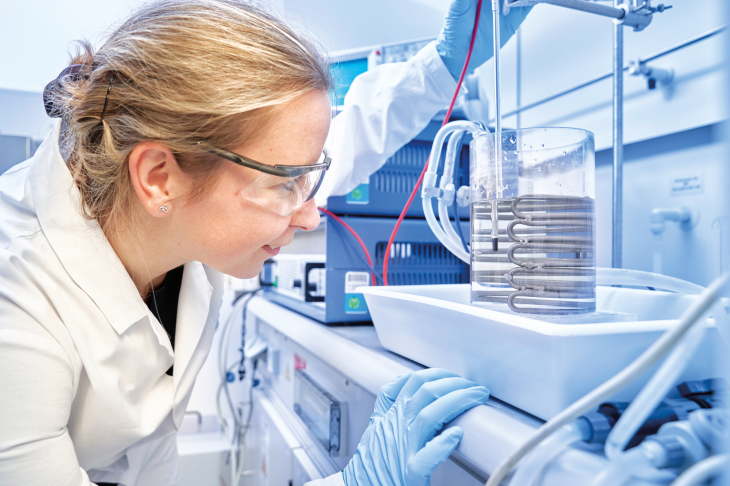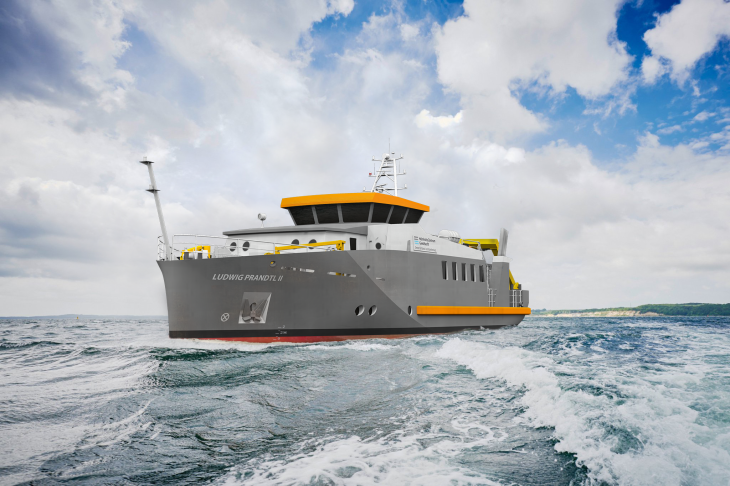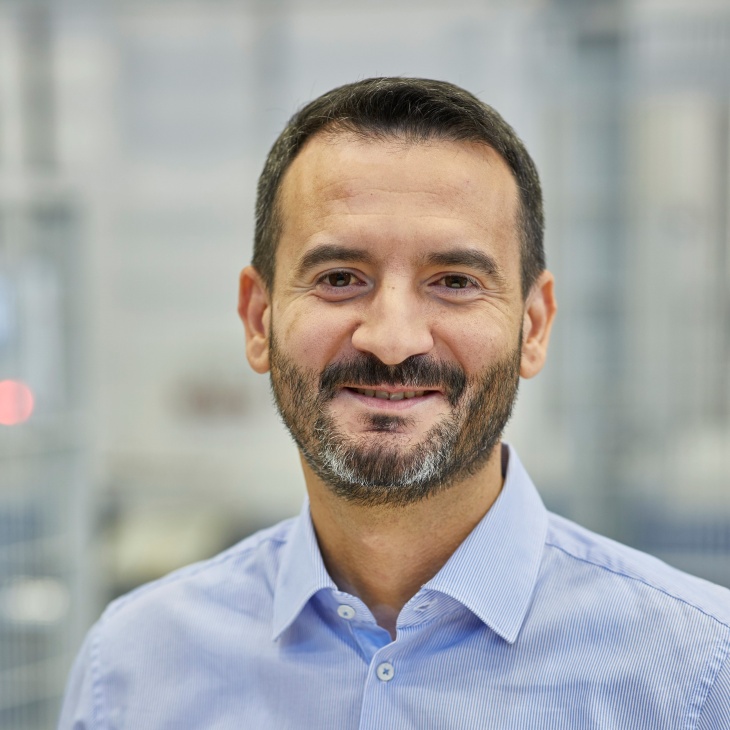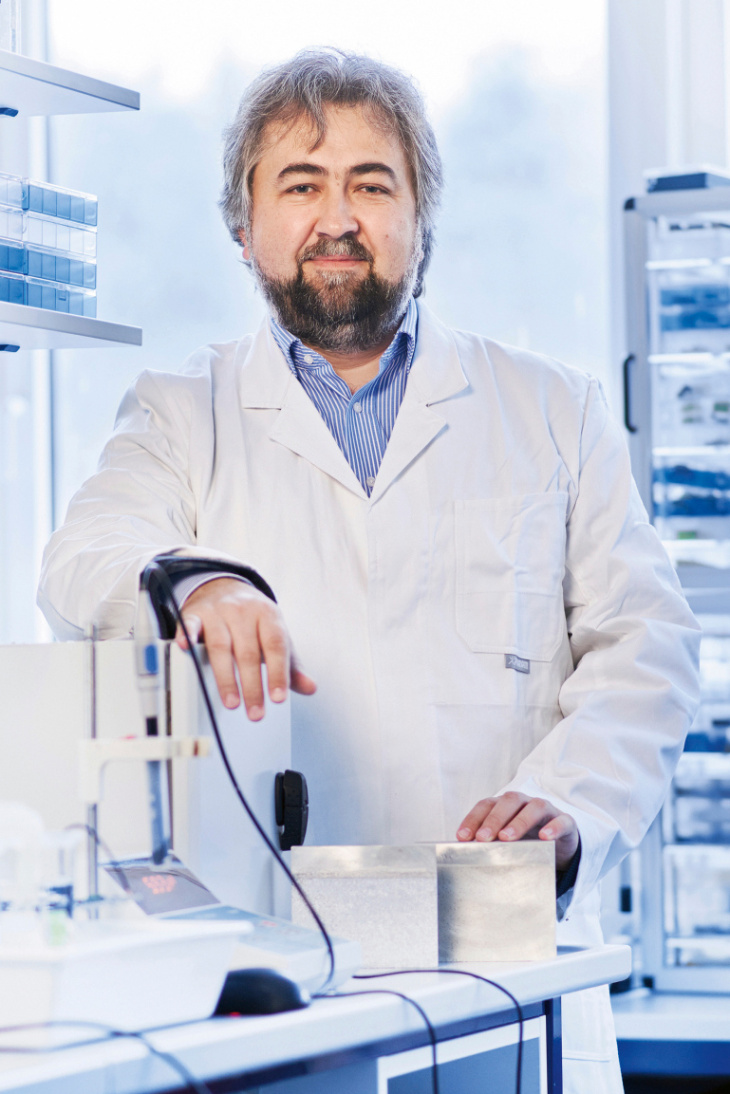Excellently positioned to tackle the challenges of the future
Please note: Since the 31st of March 2021 the Helmholtz-Zentrum Geesthacht – Center for Materials and Coastal Research has a new name: Helmholtz-Zentrum Hereon. More information www.hereon.de/name
The Helmholtz-Zentrum Geesthacht is introducing a new scientific organisational structure at the beginning of 2021. At the start of the fourth Helmholtz funding period, the centre will henceforth be represented by 15 institutes in the Helmholtz research areas of “Earth and Environment”, “Information”, and “Matter”, and will place an even greater focus on socially relevant issues across disciplines.

Maria Serdechnova from the new Institute for Surface Science examines a bone screw in an electrolyte bath. Photo: HZG/Christian Schmid
Research for the good of the climate, coast, and people
Up until the end of last year, the HZG's coastal and materials research comprised the institutes for materials research, biomaterial research, polymer research, and coastal research, which in turn were divided into sub-institutes. There is also the Climate Service Center Germany (GERICS).
As of now, the HZG is operating in 15 institutes and, with its reframing, is following the recommendations of the scientific and strategic assessments of the Helmholtz Association; these assessments have been carried out over the past three years with the help of an international team of experts.
"Smaller specialised research units will enable us to act more dynamically and leave us better placed to meet societal challenges together," explains Prof. Matthias Rehahn, Scientific Director of the HZG.
“We need to increasingly work in a cross-disciplinary manner to develop options relating to how we can live in optimum harmony with the Earth system despite resource scarcity, rapid climate change, and population growth, and how we can repair the damage that has been caused to the environment and the climate. At the same time, solutions are needed to maintain or even improve our quality of life as demographic changes occur," continues Rehahn.

This is how the research vessel could lool like. Graphic: HZG
How successfully the individual disciplines of the HZG can complement each other was confirmed, among other things, in November 2020 by the Bundestag's funding approval for a HZG concept: the realisation of the globally unique research vessel Ludwig Prandtl II. The ship is expected to be in operation from 2023, covering a broad, interdisciplinary spectrum of environmental research, digitisation, and innovative technologies for cleaner shipping. With a new information and data management system, hydrogen technology, coastal research, and membranes for reducing pollutants meet on board. This should enable relevant environmental data to be made available instantaneously and exchanged in real time with aeroplanes, land stations, and other ships.
Creative scope for excellent science
With the help of the new, organisational scientific structure, there are also incentives in place for excellent scientists. "If researchers establish themselves with a high degree of success in-house, or if we convince them to move from elsewhere in Germany or abroad to work for the HZG, we can offer attractive design options with an institute that is set to be founded," says Silke Simon, Commercial Director at the HZG, explaining the new opportunities when it comes to recruitment.
And so, on 1 January 2021, not only were previous sub-institutes converted into standalone institutes, but three completely new institutes were also founded from previous departments.
These new institutes are the Institute for Material System Modelling, the Institute for Materials and Process Design, and the Institute for Surface Science. The fields of application range from classic structural materials for mechanical engineering, automotive engineering, and aviation, through to modern functional materials for medical technology and energy storage. In addition to material and process development, digitisation and artificial intelligence methods are being utilised at an increasing rate.
Besides the restructuring, the HZG will ensure its mission has greater visibility this year, both nationally and internationally, with the help of a name change, an Internet relaunch, and a revised marketing concept.
Notice
On 16.12.22, the future name of the new research ship was found in an internal competition among Hereon staff. The ship will be called "Coriolis". The chosen name goes back to the mathematician and physicist Gaspard Gustave de Coriolis (1792-1843) and thus replaces the working title "Ludwig Prandlt II", which had been used until then.
Launch of the Institute for Material System Modelling, the Institute for Material and Process Design, and the Institute for Surface Science
Institute for Materials and Process Design

Professor Noomane Ben Khalifa. Photo: HZG/Rolf Otzipka
The new Institute for Materials and Process Design is headed by Professor Noomane Ben Khalifa and is dedicated to the sustainable and ecological development of innovative materials and manufacturing processes, particularly regarding the transport sector and medical technology. The scientists' main focus is on improving the performance of materials through their processing, thus enabling them to be produced not only more easily, but, in particular, in a more ecological and sustainable way as well. To achieve this, materials are custom-made and manufacturing processes are designed to be resource-efficient. The researchers consider each individual step in the process chain separately – starting with the modelling of material behaviour and the development of the material, all the way through to the finished component. At the heart of the new institute will be the laboratory for casting-rolling technology regarding light metals, which is currently under reconstruction, as well as a new testing hall for manufacturing processes and testing machines.
After finishing his Mechanical Engineering studies at TU Dortmund in 2005, Noomane Ben Khalifa was a research assistant at the TU Dortmund's Institut für Umformtechnik und Leichtbau until 2018. He also obtained his doctorate from TU Dortmund in 2012. Since 2018, he has been Professor of Manufacturing Technology at Leuphana University of Lüneburg and head of the former working group "Manufacturing of Light Metal Components" at the HZG.
Institute for Materials and Process Design
Institute for Surface Science

Professor Mikhail Zheludkevich in the lab. Photo: HZG/Christian Schmid
Under the direction of Professor Mikhail Zheludkevich, the focus of the new Institute for Surface Science is on the development and analysis of functional coatings and surfaces that meet the requirements of future applications in the areas of structural lightweight construction, energy research, and medical technology. Material degradation and failure is often caused by a material's surfaces interacting with complex operational environments, e.g. harsh coastal conditions or the human body. The fundamental understanding of these interactions is therefore one of the main research areas of the new institute. The sustainable goal is to increase the service life of materials used and to improve their performance across their entire life cycle. The institute will be oriented towards the increasing industrial demands for reliable functional surfaces and resilient, self-healing coatings. The experimental development of new protection and surface functionalisation concepts is largely supported and driven by AI methods and multi-scale modelling.
Since 2014, Mikhail Zheludkevich has headed the Department of Corrosion and Surface Technology at the HZG as part of a joint professorship with the Christian-Albrecht University of Kiel. Before that, he worked for ten years as a postdoc and group leader at the University of Aveiro in Portugal.
Institute for Surface Science
Institute for Material System Modelling

Professor Christian Cyron. Photo: TU München
The Institute for Material System Modelling concerns itself with methods of virtual material and process development. To this end, digitisation and artificial intelligence are to be utilised to map materials from the atomic level to the component level across various stages – from material development through to later application – using simulation models. This should enable material and process development to be accelerated and optimised. The fields of application range from classic structural materials for mechanical engineering, automotive engineering, and aviation, through to modern functional materials for medical technology and energy storage.
Institute Director Christian Cyron graduated from the Technical University of Munich with a degree in mechanical engineering in 2007, and obtained his doctorate from the same university in 2011. After stays abroad in Singapore, France, and the USA, he was appointed full professor for Continuum and Materials Mechanics at the Hamburg University of Technology in March 2018 and has since headed the department for "Simulation of Material and Structural Behaviour" at the HZG, which is now set to merge into the new Institute for Material System Modelling.
Institute for Material System Modelling
Contact
Communication and Media
Helmholtz-Zentrum Geesthacht
